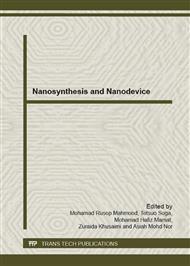p.1
p.10
p.24
p.30
p.35
p.43
p.48
p.53
Quantum Hall Effect in AlGaAs and Graphite Quantum Dots
Abstract:
Abstract. The 30 nm wide quantum wells on a 4x4 mm2 piece of GaAs/AlGaAs are formed when the layers of GaAs are deposited on AlGaAs films. The two-dimensional density of electrons is 3x1011 cm-2 and the mobility is 32x106 cm2/Vs. In such a sample the Hall resistivity as a function of magnetic field is not a linear function. Hence a suitable theory to understand the Hall effect is formulated. We find that there are phase transitions as a function of temperature. There are lots of fractions of charge which are explained on the basis of spin and orbital angular momentum of the electron. The nano meter size films of graphite also show that the Hall resistivity is non-linear and shows steps as a function of magnetic field. We make an effort to understand the steps in the Hall effect resistivity of graphite with quantum wells formed on the surface. It is found that the fractions are in four categories, (i) the principal fractions which are determined by spin and orbital angular momenta, (ii) the resonances which occur at the difference between two values such as =1-2, (iii) two-particle states which occur at the sum of the two frequencies and (iv) there are clusters of electrons localized in some areas of the sample. The spin in the clusters is polarized so that it becomes NS which is not 1/2 but depends on the number N, of electrons in a cluster.
Info:
Periodical:
Pages:
1-9
Citation:
Online since:
March 2013
Authors:
Keywords:
Price:
Сopyright:
© 2013 Trans Tech Publications Ltd. All Rights Reserved
Share:
Citation:


